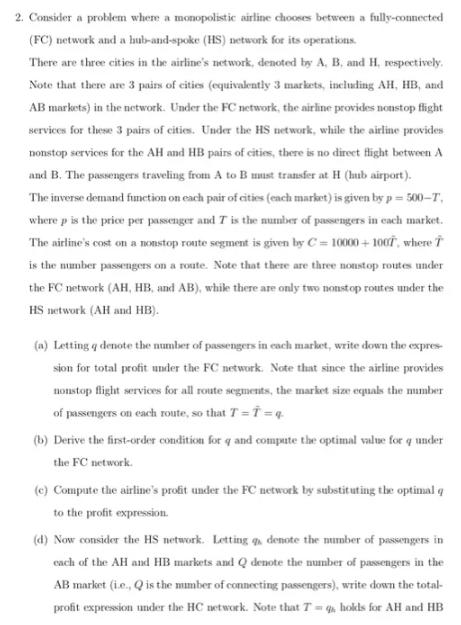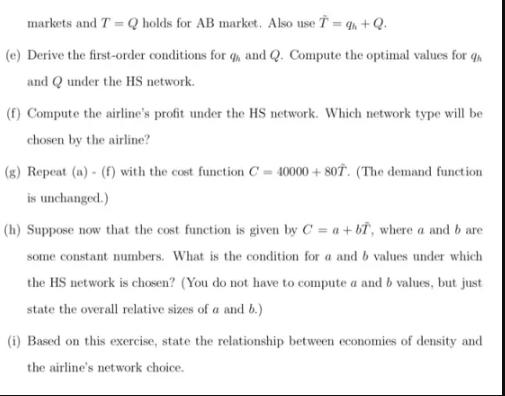Answered step by step
Verified Expert Solution
Question
1 Approved Answer
2. Consider a problem where a monopolistic airline chooses between a fully-connected (FC) network and a hub-and-spoke (HS) network for its operations. There are


2. Consider a problem where a monopolistic airline chooses between a fully-connected (FC) network and a hub-and-spoke (HS) network for its operations. There are three cities in the airline's network, denoted by A, B, and H. respectively. Note that there are 3 pairs of cities (equivalently 3 markets, including AH, HB, and AB markets) in the network. Under the FC network, the airline provides nonstop flight services for these 3 pairs of cities. Under the HS network, while the airline provides nonstop services for the AH and HB pairs of cities, there is no direct flight between A and B. The passengers traveling from A to B must transfer at H (hub airport). The inverse demand function on each pair of cities (each market) is given by p=500-T, where p is the price per passenger and 7 is the number of passengers in each market. The airline's cost on a nonstop route segment is given by C= 10000+1007, where is the number passengers on a route. Note that there are three nonstop routes under the FC network (AH, HB, and AB), while there are only two nonstop routes under the HS network (AH and HB). (a) Letting a denote the number of passengers in each market, write down the expres sion for total profit under the FC network. Note that since the airline provides nonstop flight services for all route segments, the market size equals the number of passengers on each route, so that T = T = q (b) Derive the first-order condition for q and compute the optimal value for q under the FC network. (c) Compute the airline's profit under the FC network by substituting the optimal q to the profit expression. (d) Now consider the HS network. Letting q, denote the number of passengers in each of the AH and HB markets and Q denote the number of passengers in the AB market (i.e., Q is the number of connecting passengers), write down the total- profit expression under the HC network. Note that T = q holds for AH and HB markets and T = Q holds for AB market. Also use 7 = ,+Q. (e) Derive the first-order conditions for q, and Q. Compute the optimal values for q and Q under the HS network. (f) Compute the airline's profit under the HS network. Which network type will be chosen by the airline? (g) Repeat (a)- (f) with the cost function C= 40000+807. (The demand function is unchanged.) (h) Suppose now that the cost function is given by C = a +b7, where a and bare some constant numbers. What is the condition for a and b values under which the HS network is chosen? (You do not have to compute a and b values, but just state the overall relative sizes of a and b.) (i) Based on this exercise, state the relationship between economies of density and the airline's network choice.
Step by Step Solution
★★★★★
3.37 Rating (169 Votes )
There are 3 Steps involved in it
Step: 1
a The total profit under the FC network can be expressed as the sum of profits from each market Since the airline provides nonstop flight services for all route segments the market size T equals the n...
Get Instant Access to Expert-Tailored Solutions
See step-by-step solutions with expert insights and AI powered tools for academic success
Step: 2

Step: 3

Ace Your Homework with AI
Get the answers you need in no time with our AI-driven, step-by-step assistance
Get Started


